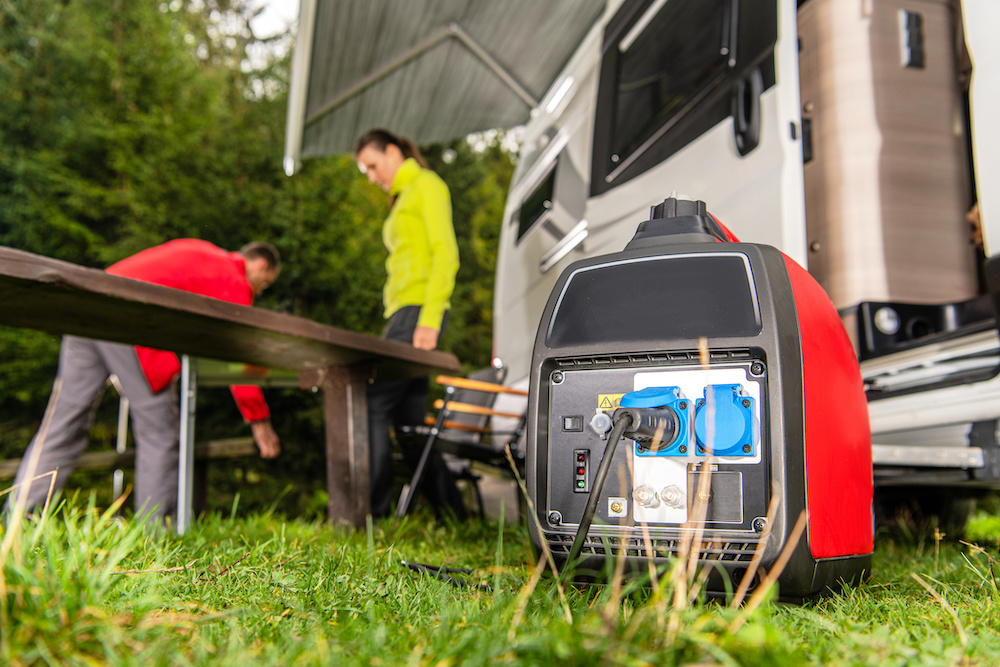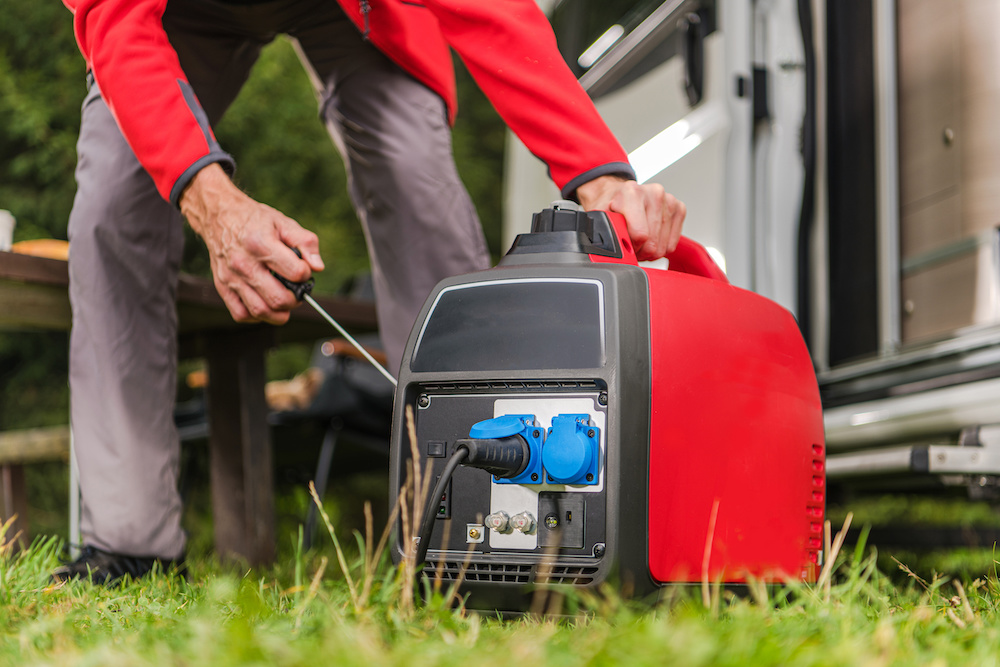Published Date: November 17, 2021
Last Updated on April 18, 2023 by Camper Front
When traveling in a trailer, you need a reliable energy source to power up your cooking equipment, AC, and other electronics.
This way, you’ll have no problems making the most out of your home away from home.
More importantly, you need something to help keep you warm in the winter.
This is where the best generators come in.
Before you decide to buy one, it would be best to learn how to use a generator with a travel trailer.
Table of Contents
What Size of Generator Do You Need for Your Trailer?
Before we talk about how to use a generator with a travel trailer, let us first determine the correct generator size needed for RVs.
Portable generators vary in size, from 2,000 to 4,000 watts. You’ll also find bigger ones, offering up to 12,000 watts of power.
You might have heard others say that you can use a traditional-style construction generator for this purpose.
However, it isn’t the best option because these models are often noisy and less efficient in terms of fuel consumption.
It’s also prone to power surges, which is not good if you are running sensitive electronics like laptops, mobile phones, and tablets.
That said, how many watts will you need? The answer depends on your power consumption needs.
Even though you won’t be running your appliances and electronics all at once, you should know how much power they each require.
For example, most electric ranges and water heaters will require bigger wattage, about 2,500 watts each. In comparison, a refrigerator will consume just around 800 watts.
A microwave needs about 1,000 watts, a coffee maker needs 900 watts, while a standard AC needs 1,400 to 2,400 watts.
Don’t forget to consider the other portable appliances you will use, such as your Bluetooth speaker, hairdryer, lamp, and more.
After figuring out the power requirements of your travel trailer appliances and accessories, it would be easier to decide the best generator size for your RV lifestyle.
You can always opt for a bigger generator but do note that the bigger the size, the heavier and noisier it is.
For sure, you don’t want to distract your neighbors at the campground with your buzzing generator.
How To Use a Generator With a Travel Trailer
After acquiring the generator that’ll fit perfectly in your travel trailer, the next step is to put it to good use. Here’s how you can do that:
Step 1: Setting up Your Trailer Generator
If you’d be using a newly-bought generator, it will have probably arrived wrapped in secure packaging.
Hence, the first step to setting it up would be to remove all packaging and shipping materials beforehand.
Before you try and test out the unit, give a thorough check.
Inspect for any cracks or damages on the body, missing components, buttons, and the like that may have happened during shipping.
You will also want to check the spark plug, wire, and oil, as well as add fuel to the tank.
Follow the manufacturer’s manual for the correct starting procedure.
Step 2: Mounting Your Generator
After making sure your generator is in good condition, it’s time to hook it up to your RV.
Some RVs have compartments for portable generators.
Unfortunately, most generators fit for RV living are bulky, which means you will most likely need a travel generator mount.
Speaking of mounts, there are different types you can choose from.
One is the A-frame cargo carrier, which you place above the propane tanks at the front of your RV.
The main advantage of this mounting option is that it’s far more secure to mount the generator on the front than on the back of your trailer.
It can also support up to 300 pounds of equipment, which is more than enough for even the heaviest generators.
However, if you have a bigger tank, you may not be able to properly fit an A-frame cargo carrier to the front of your trailer.
In this case, consider using a bumper-mounted cargo tray.
As the name suggests, it mounts on the bumper and comes with a cargo tray where you will place the generator and secure it using a chain or cable.
Most cargo trays have additional support arms and trays so that you can make them wider if you want to.
If you prefer to attach your generator directly to your bumper, you can use a hitch carrier.
The problem is, this mounting option is only advisable for smaller generator sizes.
Otherwise, your bumper could break if your generator is too heavy.
There are other kinds of mounting or installation options for travel trailer generators.
Choosing the best one for your RV depends on a few factors, such as your RV design, generator size, and your personal preference.
Step 3: Powering Your Travel Trailer
After finding the perfect spot to attach your generator, it’s time to connect it to your RV and power up your appliances.
Firstly, you’ll want to find the plug or power cord.
Travel trailers use a plug to rig up a generator. Most RVs have a 30-amp or 120-volt connection; others have a 50-amp or 120-volt connection.
A 30-amp and a 50-amp service differ in design.
The former has three prongs and is generally used on travel trailers with lower load requirements and can usually carry up to 3,600 watts.
The latter has four prongs and provides a maximum of 12,000 watts of power.
Review your owner’s manual to find out the specific plugs you need, or look at the breaker panel, which lists the amps.
This way, you’ll know exactly the correct adapter plug or cord needed for your travel trailer.

How To Use a Generator for Your Travel Trailer Safely
A generator can be the most important piece of equipment that’ll make your RV lifestyle a lot more comfortable.
However, you should remember to use it with care and caution at all times.
Mishaps like electrocution and carbon monoxide poisoning can happen if you don’t follow specific security and safety guidelines.
Here are some of the most important things to remember when running a generator for your travel trailer:
1. Set up the generator in a well-ventilated area.
Ventilation is crucial when operating a generator.
Make sure you set up and run your generator in an open space where there’s ample airflow.
It would also be best to direct the exhaust system away from you and your trailer, as well as from other people at the campsite.
If you’re concerned about the possibility of someone stealing your generator, you can secure your equipment using chains and cables.
Proper ventilation is crucial because it lowers the risk of CO poisoning.
CO is an invisible, odorless gas that can be deadly if inhaled in large amounts.
In line with this, it’s also a good idea to use a CO detector designed for travel trailers.
If you are camping off the grid, position your generator as far away from your camping area as possible.
Most RV power cords are about 20 feet long, so use this length to your advantage.
Additionally, do not place the generator near tall grass or anywhere near something that could start a fire.
2. Be mindful of your wattage consumption.
Overloading is the primary cause of tripping the breaker.
However, if you notice that your breaker trips all the time, this could be a red flag.
To avoid this from happening, try not to run all your trailer appliances at once.
For example, you can wait for your AC to cycle off before using the microwave.
Also, take note that both breakers in your travel trailer and your generator will start to wear out from regular use.
If you have a relatively old camper, check for worn-out or faulty breakers and have them replaced if needed.
3. Keep your generator well-maintained.
Inspect the exhaust system of your generator before using it. Never use a generator with a faulty exhaust system.
Next, check the fuel and oil levels before starting it up.
Different generators require unique oils depending on their fuel type.
Additionally, don’t forget about regular oil changes.
Your first generator oil change will be sooner than you think, usually just a short while after the break-in process.
Check the owner’s manual to determine when exactly you need to perform your first oil change.
You will also want to check your generator’s air inlet system.
Most units are air-cooled, so it’s crucial to ensure that no debris is blocking the cooling vents.
If you don’t do this, it could result in overheating.
Lastly, schedule a regular maintenance check with your trusted technician.
The general recommendation for generator maintenance is after 50 or 100 hours of run time.
The 100-hour service is a good time to check for the spark plugs or ignition points, contact surfaces (which should be clean and smooth), and the point gap.
It’s a good idea to keep a maintenance log and record the hours you’ve used your generator.
Then, compare these numbers to the hours shown on the equipment’s running clock.
You Don’t Have To Sacrifice Your Comfort
A generator is a very useful piece of equipment for any travel trailer, allowing you to live comfortably while on the road.
Using one with a travel trailer is relatively easy because most RVs already have built-in power circuitry.
All you need to do is connect it to your generator using the correct plug connection, and you’d be good to go.
That said, make sure you observe safety measures when installing and operating your generator, as we’ve outlined above.
At this point, you’re ready to power up your travel trailer and embark on a fun-filled road trip.

